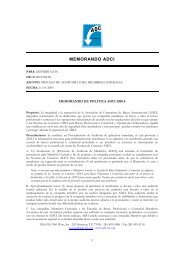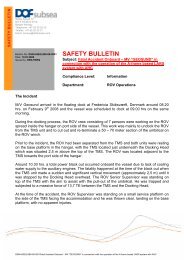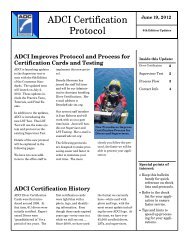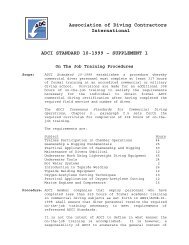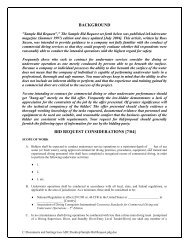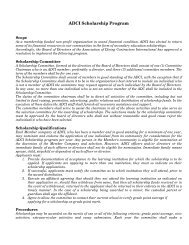DIRECTIVE NUMBER: CPL 02-00-151 EFFECTIVE DATE ... - OSHA
DIRECTIVE NUMBER: CPL 02-00-151 EFFECTIVE DATE ... - OSHA
DIRECTIVE NUMBER: CPL 02-00-151 EFFECTIVE DATE ... - OSHA
You also want an ePaper? Increase the reach of your titles
YUMPU automatically turns print PDFs into web optimized ePapers that Google loves.
issues commercial diver certification cards in accordance with the ADCI Consensus Standards<br />
for Commercial Diving and Underwater Operations (Section 3.0, 6 th Edition (2011)). <strong>OSHA</strong><br />
considers an employer to be in compliance with the 29 CFR 1910.410 diver-training<br />
requirements when the employed divers have a valid ADCI commercial diver certification card<br />
indicating the appropriate training level.<br />
Question #5: Do the Consensus Standards for Commercial Diving and Underwater<br />
Operations published by the Association of Diving Contractors International (ADCI)<br />
comply with <strong>OSHA</strong> and U.S. Coast Guard requirements for commercial diving operations<br />
For diving operations that are not covered by <strong>OSHA</strong> or U.S. Coast Guard regulations, such<br />
as maintenance and repair of pressure vessels for human occupancy (PVHO) or handling<br />
systems for diving bells, what does <strong>OSHA</strong> recognize as the best industry practice<br />
Answer: <strong>OSHA</strong> recognizes the ADCI Consensus Standards for Commercial Diving and<br />
Underwater Operations as meeting the general requirements of 29 CFR 1910.420 for a safe<br />
practices manual. The contents of this document meet or exceed the requirements of 29 CFR<br />
Part 1910, Subpart T. For diving-related operational, maintenance, and testing matters that are<br />
not addressed by <strong>OSHA</strong> standards, <strong>OSHA</strong> recognizes ADCI standards as the best established<br />
industry practice.<br />
<strong>OSHA</strong>’s recognition of the ADCI standards is consistent with the position taken by the U.S.<br />
Coast Guard. In a letter from the U.S. Coast Guard, Chief, Office of Compliance, to the ADCI<br />
dated February 9, 2<strong>00</strong>5, the U.S. Coast Guard stated, “Of significance, ADCI’s Consensus<br />
Standards for Commercial Diving and Underwater Operations fully meet and exceed the Coast<br />
Guard’s regulatory requirements for commercial diving operations found in 46 CFR 197. Now<br />
in its Fifth Edition, the ADCI Consensus Standards are considered commercial diving industry<br />
best practices and are recognized and used by the United States Coast Guard as our<br />
comprehensive guidance document.”<br />
NOTE: The ADCI Consensus Standards for Commercial Diving and Underwater Operations is<br />
now in its 6th Edition (2011).<br />
Question #6: How is a determination made of a safe or minimum operating pressure for<br />
commercial diving surface-supplied equipment<br />
Answer: The minimum safe operating pressure for any surface-supplied diving system is<br />
dependent upon three principal factors: (1) the depth of the dive; (2) pressure loss through the<br />
diving air-supply hose; and (3) the pressure requirements for the diving helmet or mask. Equally<br />
important is the flow (volume) of air supplied to the diver. Employers must comply with the<br />
manufacturers’ recommended operating pressures and flow requirements for diving helmets and<br />
masks, and all diving systems must be analyzed by a competent person to ensure that the systems<br />
will support the diving operations adequately.<br />
As required by 29 CFR 1910.430(h)(2), a surface-supplied air helmet or mask must have a<br />
minimum ventilation rate capability of 4.5 acfm at the depth of the dive, or the capability of<br />
maintaining the diver’s inspired carbon-dioxide partial pressure below 0.<strong>02</strong> ATA when the diver<br />
is producing carbon dioxide at a rate of 1.6 standard liters per minute. Diving system flow<br />
requirements must be analyzed as follows: (1) the flow volume of breathing gas needed by the<br />
A-3


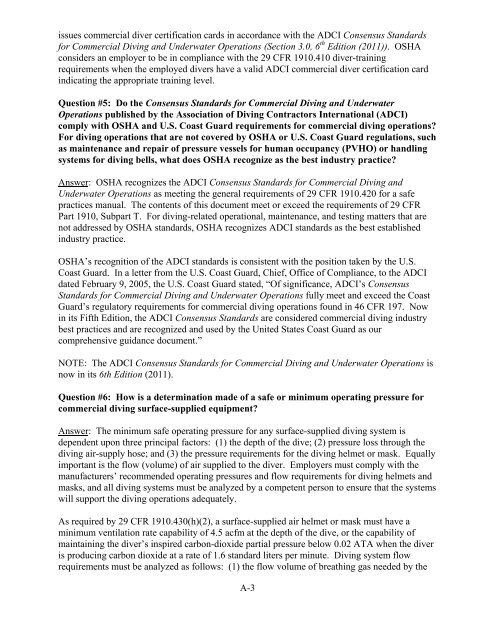
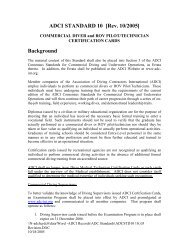
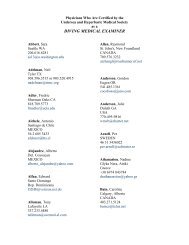
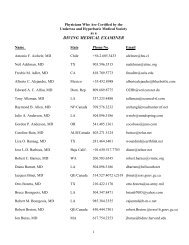
![SOLICITUD MEMBRESIA ASOCIADO [Rev 06/08] - Association of ...](https://img.yumpu.com/48291988/1/190x245/solicitud-membresia-asociado-rev-06-08-association-of-.jpg?quality=85)

